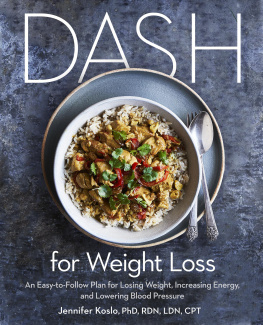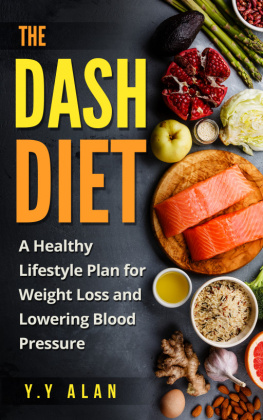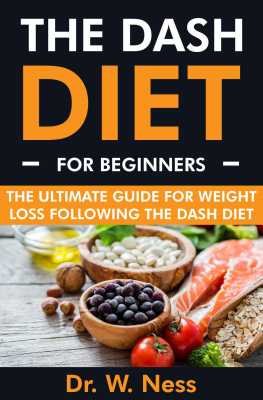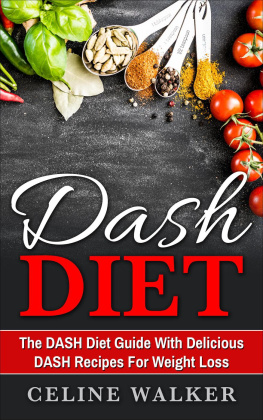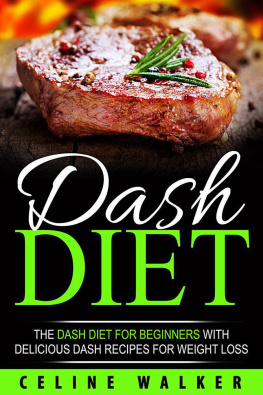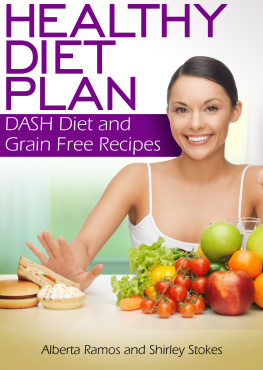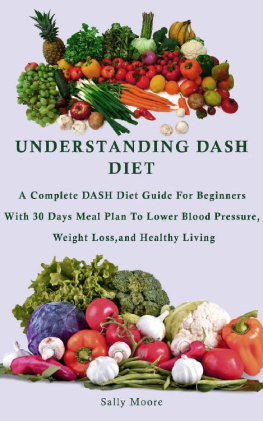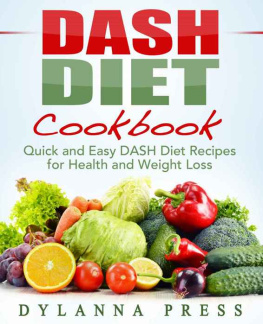Contents
Landmarks
Print Page List
Acknowledgments
I would like to thank my mom and my cousin Bonny Groff for all of their hard work with the bulk of the recipe testing, and all of the eager samplers who gave valuable feedback on the recipes.
DASH : HOW THE HEALTHIEST DIET WORKS
Health Benefits of DASH
The DASH diet has helped people with hypertension and pre-hypertension lower their blood pressure for over twenty years. By reducing blood pressure, this diet can also decrease the need for costly medications. Even if hypertension is not your main concern, DASH is a great option for anyone who wants to adopt a healthy diet in general. Because DASH emphasizes moderate portions and whole, unprocessed foods, a beneficial side effect for most people is weight loss.
DASH is actually quite simple. It encourages you to eat less of the foods you already know really arent the best options for your waistline or health, including fast food, processed foods, refined carbohydrates, red meat, sugar-filled beverages, prepackaged dishes, and salty foodsyou get the idea. And it includes a variety of foods to eat more of, such as whole grains, vegetables, fruits, beans, nuts, healthy fats, lean meats, and low-fat dairy.
DASH is not a low-carb diet. It is not a vegan or vegetarian diet, or even one that is restrictively low in sodium. The original DASH trial included a sodium level of 2,300 milligrams per day, which is the amount recommended in the 20152020 Dietary Guidelines for Americans. Yet, after only two weeks of following the DASH diet, the participants in the study experienced a drop in blood pressure.
In addition to lower blood pressure, some of the other benefits to following the DASH diet include:
However, keep in mind that the amount of time it takes to lower your blood pressure depends on a variety of factors including your age, gender, current health status, race, weight, co-morbidities (for example, type 2 diabetes, kidney disease), and so on. Please do not stop taking your medications (high blood pressure, diabetes, or any other prescription medication) when you embark on the DASH diet, as this could put you at risk for life-threatening complications. Always consult with your physician and let him/her know you are making dietary and lifestyle changes so that they may adjust your medications accordingly when the time is right.
Additionally, it is very important to have realistic expectations of outcomes from following the DASH diet. The older we get, the harder it becomes to lose weight due to a slower metabolism and loss of muscle mass. In other words, what worked for weight loss at age 20 wont work at 30, 40, or 50+. But you can still make significant changes in your healthjust be patient. Focus on progress rather than perfection. View it as a lifestyle change and not a temporary fix. Even if you dont notice immediate changes in your weight, within two to four weeks, you should notice improvements in your digestion, concentration, energy level, and body shape.
Hypertension Basics
You have probably heard the saying that high blood pressure is a silent killer, but what exactly does that mean? High blood pressure (hypertension) often has no obvious symptoms, and if left undiagnosed and untreated, the damage it does to your circulatory system could increase your risk for a heart attack or stroke, and can lead to heart disease, kidney disease, heart failure, and damage to your eyes.
While everyone wants to have a healthy blood pressure, the parameters for what qualifies as normal or healthy just got a lot stricter based on new guidelines released at the end of 2017 by a joint committee of the American College of Cardiology and the American Heart Association.
Blood pressure readings are expressed in millimeters of mercurythe unit is abbreviated as mm Hg. The new blood pressure guidelines categorize hypertension as a reading of 130/80 mm Hg from the previous standard of 140/90 mm Hg. to see what your blood pressure readings indicate.
In order to understand your readings, it is helpful to know how your blood pressure works, without getting too scientific. Blood pressure is the force that your heart exerts against the resistance that your arteries create to keep blood flowing through your body. When you get your blood pressure taken, its expressed as a measurement with two numbers: For example: 120/80 mm Hg. The top number ( systolic ) refers to the amount of pressure in your arteries during the contraction of your heart muscle. The bottom number ( diastolic ) refers to your blood pressure when your heart muscle is in between beats. Both numbers are important for determining if your heart is working too hard to pump blood to the rest of your body.
DOES DIETARY CHOLESTEROL STILL MATTER?
Nutrition guidelines can certainly be confusing. For years, the public was told to limit dietary cholesterol to no more than 240 milligrams per day. Now with the 20152020 Dietary Guidelines for Americans, the limit on cholesterol has been completely removed. So what gives? The cholesterol in our blood does not come directly from cholesterol in the foods we eat. With that said, what we eat can still raise our blood cholesterol. The type and amount of fat we eat is what makes the impact on our cholesterol, and some fats are more harmful than others. The worst type of fat for your heart and cholesterol is trans fats, which the Food and Drug Administration has determined to be unsafe and therefore removed from our food supply. This change officially went into effect on June 21, 2018, so you should look for 0 grams of trans fats on ingredient labels or in foods. Saturated fats, such as those found in animal products, also raise bad or LDL cholesterol; however, recent research suggests that some types, such as the fats found in chocolate and coconut oil, do so less than others.
Bottom line: Avoid trans fats all together and keep saturated fats and tropical oils in check. Choose extra-virgin olive oil most often.
Know Your Numbers: Blood Pressure Readings Explained
The chart below shows the newly defined categories. If you have your numbers, you can see what they mean.
FULL-FAT, LOW-FAT, OR FAT-FREE DAIRY?
DASH has been tested using full-fat dairy products instead of low-fat or fat-free to see if adding certain foods will keep it as beneficial. In a recent study published in the American Journal of Clinical Nutrition, researchers found that the DASH diet with higher-fat dairy was just as beneficial in lowering blood pressure as the standard DASH diet. To compensate for the extra calories, participants consumed less sugar. The takeaway here is that it is possible to accommodate a variety of preferences when following DASH and still obtain significant health benefits.
Risk Factors
There are a number of factors that can increase your risk of high blood pressure that are simply out of your control. These include being over age 50, being male or a postmenopausal female, being black, and/or having a family history of high blood pressure.
Preventive Measures
On the flip side, there are many preventive steps you can take to lower your risk of developing high blood pressure that are entirely within your control. These include:

